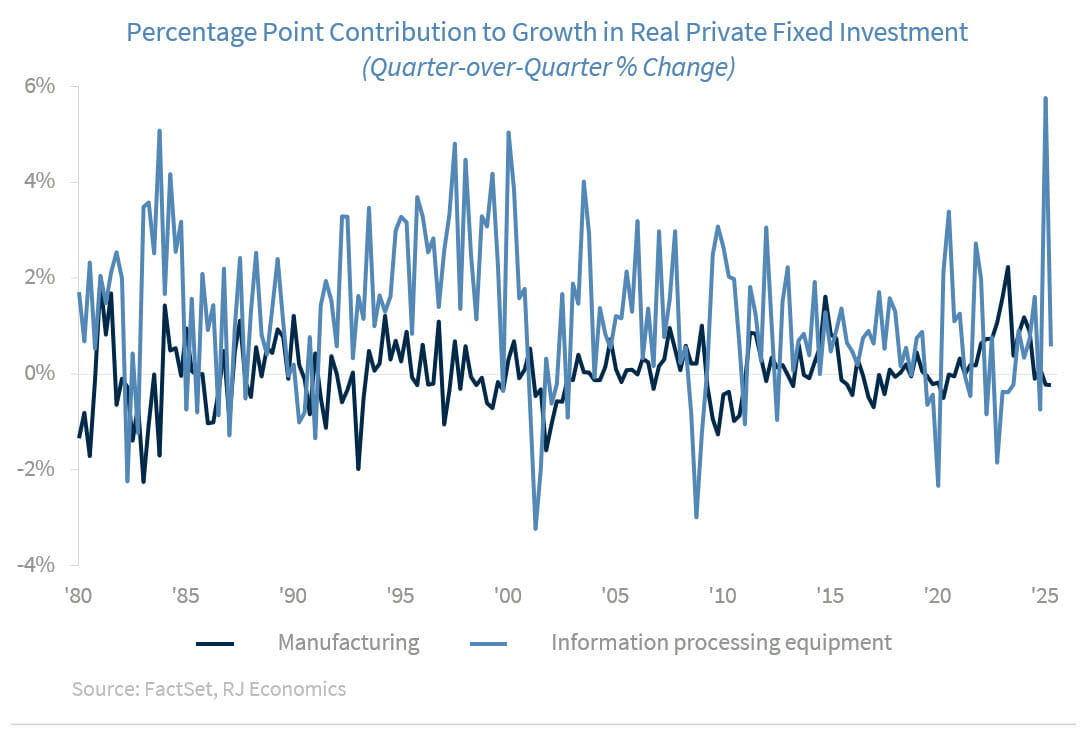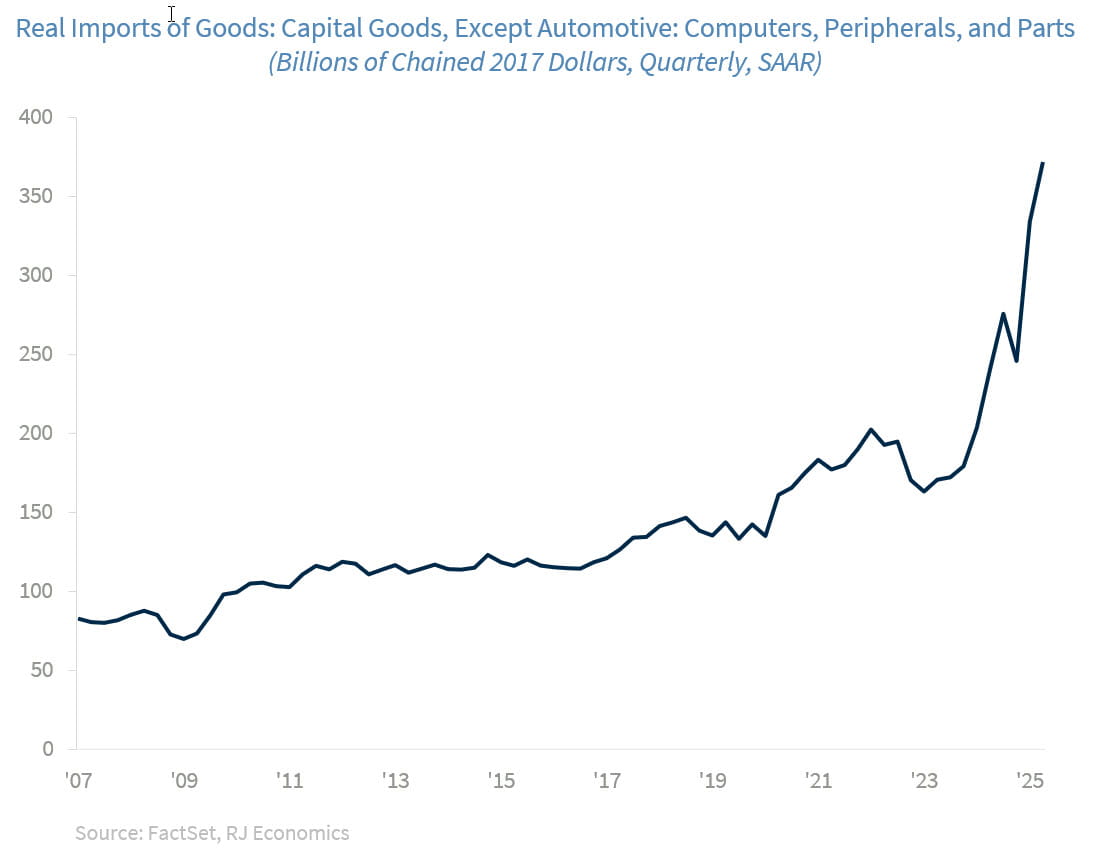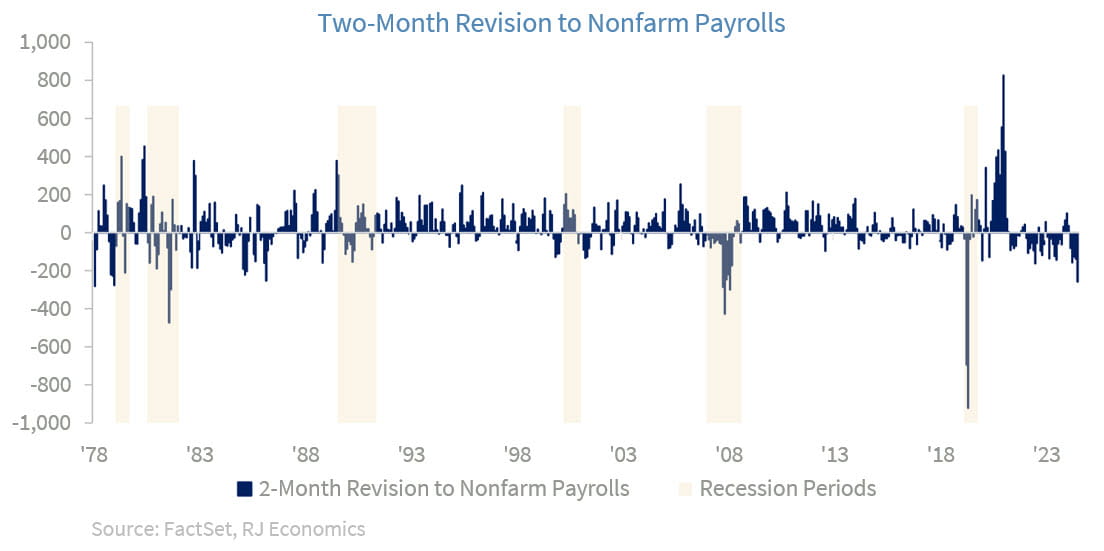Is AI coming to the rescue?
Chief Economist Eugenio J. Alemán discusses current economic conditions.
Most economists, including us, were wrong about the ‘ensuing’ recession back in 2022 and 2023 as the US Federal Reserve (Fed) increased interest rates to fight higher inflation. Typically, very high interest rates push real investment lower, especially real investment in residential construction, and the economy goes into recession, slowly or due to a shock, as interest rate-vulnerable sectors give in.
But that time was different, as non-residential investment remained afloat and relatively immune to high interest rates due to, among other things, a surge in investment in manufacturing plants incentivized by the IRA and the CHIPS Act. We can see the surge in the percentage point contribution from real investment in manufacturing plants in dark blue in the graph below, from a sector that is relatively small but was pulling above its weight during the period from 2022 to almost 2024. Today, it is not real investment in manufacturing plants, but real investment in information processing equipment, which has increased its contribution to the growth of real gross fixed private investment and has been relatively immune to high interest rates, as shown in light blue the graph below.
The contribution to the growth of real gross fixed private investment from the information processing equipment sector during the first quarter of 2025 was an impressive 5.8 percentage points of the 6.4 percentage points contributed by real investment in equipment, the highest quarterly contribution from this sector since 1980.
Although investment in AI seems to have been pushing real investment in information processing equipment over the last year or so, the surge in Q1 2025 could also be explained by companies front- loading purchases of these capital goods ahead of the implementation of tariffs. However, it is also clear, from the graph below, that even if that is true, the surge in real imports of capital goods of information processing equipment started before tariffs were a real threat and continued to remain strong during the second quarter of the year, as shown by the graph below.
Thus, although economic activity has been weakening in the face of very high interest rates, a new sector, which seems immune to high interest rates due to the expectations of strong profitability over time, the AI sector, seems to continue to keep real investment, i.e., the most volatile sector of the economy, above ground.
The convergence of soft and hard data
During the first part of the year, but especially since the start of this administration’s successive tariff announcements, soft data has been showing a weakening economy, while hard data, especially the employment numbers, have been showing a still strong economic performance. This changed on August 1, 2025, when the Bureau of Labor Statistics showed a weak nonfarm employment number for July, up 73,000, while at the same time it made large downward revisions to previously reported strong employment numbers in May and June. The two previous months’ downward revision was very large, showing 258,000 fewer jobs created than originally estimated for the two months taken together. This means that, on average, jobs created during the last three months ending in July were just 35,333, with just 19,000 jobs created in May, 14,000 in June, and 73,000 in July.
If these revisions, which have been large and mostly lower since the start of the year, continue, we may see negative employment numbers before the end of the year, especially starting in October, which is when most of the Federal Government employees who accepted the buyout will start dropping off the US Government payrolls.
All of this information means that, finally, hard data, which had been looking better than soft data, is catching up with the weaker soft data, and this could mean trouble for economic activity during the second half of the year.
For now, as we stated in the first section, the AI revolution seems to be keeping the US economy (and the stock market) afloat. However, the US economy cannot, at this time, afford much weaker employment and thus, much weaker income growth because it could tip economic growth lower. At the same time, if we get further weakening in real investment going forward, especially in real residential investment, not even investment in AI is going to prevent the economy from falling into a recession.
All these arguments are in line with our view that the Fed needs to lower interest rates as soon as possible.
Economic and market conditions are subject to change.
Opinions are those of Investment Strategy and not necessarily those of Raymond James and are subject to change without notice. The information has been obtained from sources considered to be reliable, but we do not guarantee that the foregoing material is accurate or complete. There is no assurance any of the trends mentioned will continue or forecasts will occur. Past performance may not be indicative of future results.
Consumer Price Index is a measure of inflation compiled by the US Bureau of Labor Statistics. Currencies investing is generally considered speculative because of the significant potential for investment loss. Their markets are likely to be volatile and there may be sharp price fluctuations even during periods when prices overall are rising.
Consumer Sentiment is a consumer confidence index published monthly by the University of Michigan. The index is normalized to have a value of 100 in the first quarter of 1966. Each month at least 500 telephone interviews are conducted of a contiguous United States sample.
Personal Consumption Expenditures Price Index (PCE): The PCE is a measure of the prices that people living in the United States, or those buying on their behalf, pay for goods and services. The change in the PCE price index is known for capturing inflation (or deflation) across a wide range of consumer expenses and reflecting changes in consumer behavior.
The Consumer Confidence Index (CCI) is a survey, administered by The Conference Board, that measures how optimistic or pessimistic consumers are regarding their expected financial situation. A value above 100 signals a boost in the consumers’ confidence towards the future economic situation, as a consequence of which they are less prone to save, and more inclined to consume. The opposite applies to values under 100.
Certified Financial Planner Board of Standards Center for Financial Planning, Inc. owns and licenses the certification marks CFP®, CERTIFIED FINANCIAL PLANNER®, and CFP® (with plaque design) in the United States to Certified Financial Planner Board of Standards, Inc., which authorizes individuals who successfully complete the organization’s initial and ongoing certification requirements to use the certification marks.
Links are being provided for information purposes only. Raymond James is not affiliated with and does not endorse, authorize or sponsor any of the listed websites or their respective sponsors. Raymond James is not responsible for the content of any website or the collection or use of information regarding any website's users and/or members.
GDP Price Index: A measure of inflation in the prices of goods and services produced in the United States. The gross domestic product price index includes the prices of U.S. goods and services exported to other countries. The prices that Americans pay for imports aren't part of this index.
Employment cost Index: The Employment Cost Index (ECI) measures the change in the hourly labor cost to employers over time. The ECI uses a fixed “basket” of labor to produce a pure cost change, free from the effects of workers moving between occupations and industries and includes both the cost of wages and salaries and the cost of benefits.
US Dollar Index: The US Dollar Index is an index of the value of the United States dollar relative to a basket of foreign currencies, often referred to as a basket of U.S. trade partners' currencies. The Index goes up when the U.S. dollar gains "strength" when compared to other currencies.
The FHFA HPI is a broad measure of the movement of single-family house prices. The FHFA HPI is a weighted, repeat- sales index, meaning that it measures average price changes in repeat sales or refinancings on the same properties.
Import Price Index: The import price index measure price changes in goods or services purchased from abroad by U.S. residents (imports) and sold to foreign buyers (exports). The indexes are updated once a month by the Bureau of Labor Statistics (BLS) International Price Program (IPP).
ISM Services PMI Index: The Institute of Supply Management (ISM) Non-Manufacturing Purchasing Managers' Index (PMI) (also known as the ISM Services PMI) report on Business, a composite index is calculated as an indicator of the overall economic condition for the non-manufacturing sector.
The ISM Manufacturing Index: The GDP Now Institute of Supply Management (ISM) Manufacturing Measures the health of the manufacturing sector by surveying purchasing managers at manufacturing firms. The survey asks about current business conditions and expectations for the future, including new orders, inventories, employment, and deliveries.
Consumer Price Index (CPI) A consumer price index is a price index, the price of a weighted average market basket of consumer goods and services purchased by households.
Producer Price Index: A producer price index (PPI) is a price index that measures the average changes in prices received by domestic producers for their output.
Industrial production: Industrial production is a measure of output of the industrial sector of the economy. The industrial sector includes manufacturing, mining, and utilities. Although these sectors contribute only a small portion of gross domestic product, they are highly sensitive to interest rates and consumer demand.
The NAHB/Wells Fargo Housing Opportunity Index (HOI) for a given area is defined as the share of homes sold in that area that would have been affordable to a family earning the local median income, based on standard mortgage underwriting criteria.
Conference Board Coincident Economic Index: The Composite Index of Coincident Indicators is an index published by the Conference Board that provides a broad-based measurement of current economic conditions, helping economists, investors, and public policymakers to determine which phase of the business cycle the economy is currently experiencing.
Conference Board Lagging Economic Index: The Composite Index of Lagging Indicators is an index published monthly by the Conference Board, used to confirm and assess the direction of the economy's movements over recent months.
New Export Index: The PMI New export orders index allows us to track international demand for a country's goods and services on a timely, monthly, basis.
Gold is subject to the special risks associated with investing in precious metals, including but not limited to: price may be subject to wide fluctuation; the market is relatively limited; the sources are concentrated in countries that have the potential for instability; and the market is unregulated.
The Conference Board Leading Economic Index: Intended to forecast future economic activity, it is calculated from the values of ten key variables.
Source: FactSet, data as of 7/25/2025





